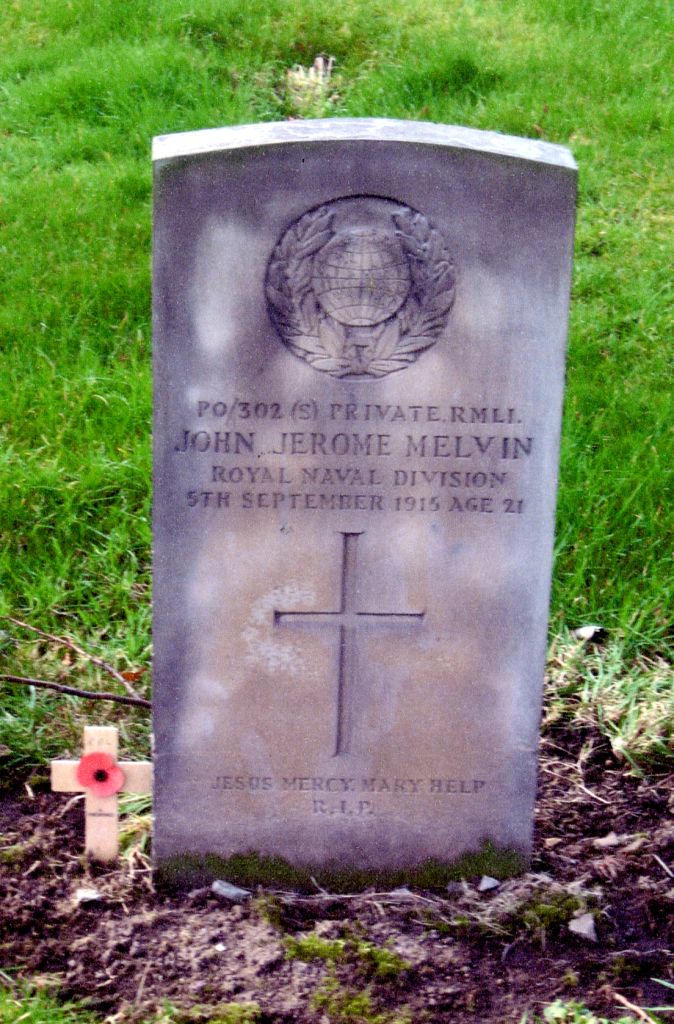John Jerome Melvin
Date of birth: 18.8.1894
Date of death: 5.9.1915
Area: Normanton
Regiment: Royal Marine Light Infantry
Family information: Son of Mary Ann and Patrick Melvin, 6 Bridge Street, Castleford Road, Normanton
Rank: Private
Service number: PO/ (302) 5
War Service
On August 14th 1914, just 14 days before John’s twentieth birthday, war was declared on Germany and probably, as with many other young men there would be plenty of talk and discussion taking place about what they would do and how they would do it.
Consequently on the 3rd November 1914, John and several other young chaps from Normanton journeyed to the city of York, where they enlisted in the Royal Marine Light Infantry C company, Naval Division, Portsmouth battalion PO/302(S) In his service record he is described as 5’ 71/4” tall, fresh complexion, hair brown, eyes blue, scars nil.
Assigned to C company Portsmouth division he then went to HMS Victory, Royal Marine Brigade (probably a training establishment, not Nelson’s flagship) January 1915 and then with the Royal marine Brigade he embarked for Lemnos and was stationed off the Gallipoli peninsular (Dardanelles) as part of the Mediterranean Expeditionary Force. After the naval attack failed they were evacuated to Port Said in Egypt, returning to Gallipoli 25 April.
Three days later on 28th April 1915, John was struck down by enteric fever and was evacuated back to England and treated at the Royal Naval hospital Haslar, Gosport, Hampshire.
His comrade in arms and friend from Normanton, Private John Halman, service no PO/304(S) of the same battalion died 13 July 1915 in Gallipoli. He was the son of Selina Halman of 45 Hope St Normanton and the late James Halman. His late father and three brothers also served in the war.
Unfortunately, John’s illness had weakened him to such a point that he passed away on 5th September 1915, just eighteen days after his 21st birthday and only eleven months after enlisting. His cause of death is described as- 1) Enteric fever (typhoid fever) and dysentery. 2) Haemorrhage.
Incidentally, of the 213,000 British casualties on Gallipoli, 145,000 were due to disease, the main causes were typhoid fever, diarrhoea and dysentery
After his death he was brought back to his hometown, Normanton, by train.
His funeral was described in the Wakefield Express 11th September 1915 and is headlined “Impressive military funeral at Normanton”.
“There very impressive scenes in Normanton on Thursday afternoon with the internment of Private John Jerome Melvin”.
“For the internment it seemed as though everybody in the little town had turned out to show a last sign of respect to one of the many Normanton men who have given their lives in this great struggle. The ceremony was carried out with full military honours”.
The service was at the Roman Catholic Church and the road to the cemetery was lined with sympathisers. All along the route the blinds were down in the shops and private houses. The cortege was led by the band of the Kings Own Yorkshire Light Infantry from Pontefract Barracks. The coffin was covered with a large Union Jack and carried by relays of bearers in Khaki. There were many tearful eyes among the onlookers who witnessed the coffin followed by a carriage bearing the chief mourners and walking behind were a number of soldiers on leave, four Belgian refugees and close upon two hundred neighbours and friends. At the graveside the last post was sounded and three volleys were fired.
He was buried in Lower Cemetery, Normanton with his Granddad Patrick Crean and Grandmother Catherine Crane (note Crean and Crane name changes at times).
Family Life
John Melvin, known by his family as Jerome was born on18 August 1894, the first son of Patrick and Mary Ann Melvin. His father, Patrick was an Irish migrant who came to the small agricultural town of Sherburn in Elmet in 1890 and marred Mary Anne Crane in Roman Catholic chapel in Scarthingwell and settled down to live in Old Chapel Yard, Sherburn.
John was educated at the local school.
Sometime between 1906 and 1910, the family moved to Normanton to seek work in the coal mines and worked at St John’s Colliery, Newland lane, Normanton. Like his father, John worked in the mines. Interestingly, St John’s was nicknamed the ‘hail Mary pit’, presumably due to the high proportion of catholic workers there. They lived at 6 Bridge Street, Castleford Road, Normanton.
After the war, 24 September 1917, the family were awarded a £5 war gratuity.
According to his service record, his character was ‘very good’ and the large turn out at his funeral would imply that he was popular in his hometown.
 John Jerome Melvin's gravestone
John Jerome Melvin's gravestone

